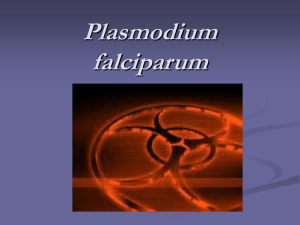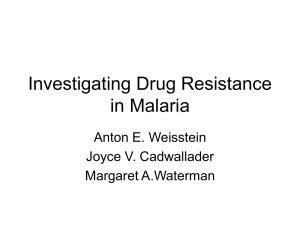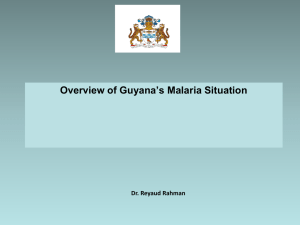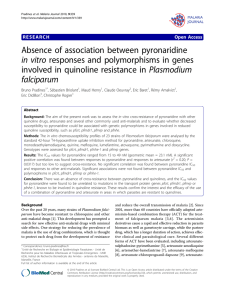محاضرة 10
advertisement
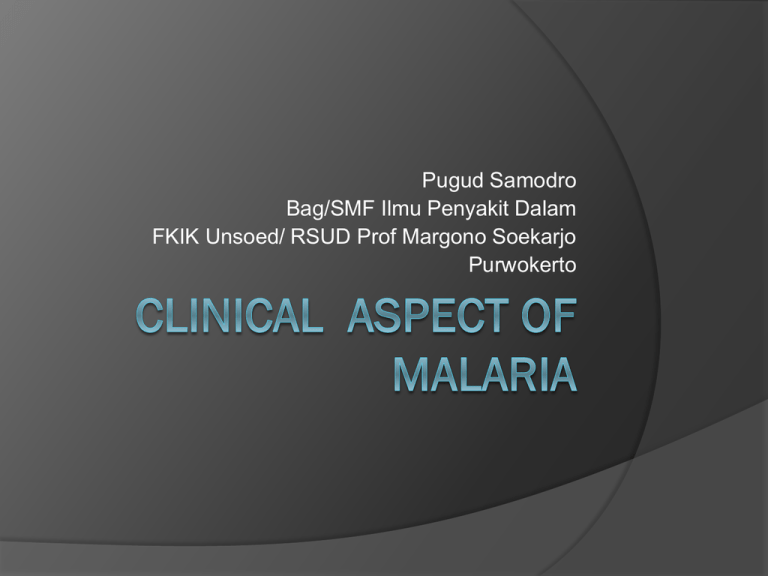
Pugud Samodro Bag/SMF Ilmu Penyakit Dalam FKIK Unsoed/ RSUD Prof Margono Soekarjo Purwokerto What is Malaria? Parasitic infection of human red blood cells 4 species can infect humans Plasmodium falciparum Plasmodium vivax Plasmodium malariae Plasmodium ovale Pictures of P. falciparum Etiology Causative organism: Plasmodia P. Vivax: tertian malaria P. Malariae: quartan malaria P. Falciparum: malignant malaria P. Ovale: tertian malaria Pathogenicity: merozoite, malarial pigment & products of metabolism Plasmodium falciparum Most dangerous form of malaria Risk of cerebral malaria, renal failure, acute respiratory distress syndrome, severe anemia Prompt treatment is essential Untreated infection in a non-immune person would likely be fatal Once person is treated and cured, there is no risk of relapse (but you can get infected again…) P. falciparum has no dormant liver stage (hypnozoite) P. vivax and P. ovale Less likely to be life threatening than P. falciparum Symptoms (especially fever) can still be dramatic Different drugs are used to treat blood and liver stage parasites Etiology Two period: human - whole asexual reproduction mosquito - sexual parasitic stage Two host: human - intermediate host mosquito - final host notes: clinical symptoms: erythrocytic stage relapse: exerythrocytic stage infectivity: sporozoite Epidemiology Source of infection Patient, parasite carrier Route of transmission female mosquito biting person blood transfusion Susceptibility: universal susceptibility no-cross-immunity re-infection Epidemic features: sporadic or endemic, tropic or subtropic What is the Malaria Vector? Spread by bite of infected female Anopheles mosquitoes Night-biting mosquitoes Indoor-biting mosquitoes Pathogenesis Mechanism of attack RBC rupture merozoite malaria pigment products of metabolism blood stream allergy P. Falciparum: produce microvascular disease magnitude of the parasitemia & age of patient no specific Ab or cell -mediated response Malaria Lifecycle Human Liver Stages Mosquito Stages Exo-erythrocytic (hepatic) Cycle: Sporogonous Cycle: Human Blood Stages P. falciparum Erythrocytic Cycle: Gametocytes P. vivax P. ovale P. malariae Pathology Anemia: P. Vivax - retiform RBC P. Malariae - mature RBC P. Falciparum - every RBC Prolifeation of mononuclear phagocyte hepatomegaly splenomegaly Cerebral edema & congestion Symptoms of Malaria Fever is by far the most common symptom, but is by no means the only one Often can have constellation of symptoms described as “flu-like” Other symptoms can include: chills, fatigue, weakness, headache, nausea, vomiting, diarrhea, muscle aches, mental status changes Clinical manifestation Incubation period: quartan malaria: 24-30 day tertian malaria: 13~15 day malignant malaria: 7~12 day Clinical manifestation Typical attack Chill: abrupt onset, shivering, pale face,cyanosis. Last 10 min or 1~2hr. High fever: T rise to 40oC with malaise, myalgia, thirsty. Last 2~6 Hr. Sweating: profuse sweating with restlessness regular 48 hr. or 72 hr. Cycle Clinical manifestation Signs anemia splenomegaly hepatomegaly, ALT elevate Clinical manifestation Perniciouse attack: cause by P. Falciparum cerebral malaria high fever, headache, vomiting, convulsion delirum, respiratory failure hyperpyrexia type T> 420C, convulsion, delirium Relapse: early relapse - <3m, later relapse - >6m Clinical manifestation Malaria caused by transfusion incubation period: 7~10 day no exerythrogenic phase, no relapse Complications Black- water- fever: cause:1/inadequate G-6-PD 2/The toxin release by malarial parasite 3/Allergic reaction to anti-malarial drugs feature:1/chill & fever 2/dark red or black urine 3/severe hemolytic anemia Acute glomerulonephritis Malaria Mortality 2 main ways it kills: Anemia Parasites destroy red blood cells Associated with increased mortality Cerebral malaria Damages brain and other vital organs Fatality rate of 15% or more Laboratory Findings Blood picture: decrease in RBC & Hb blood film for parasite serological examination ELISA for P. antigen DNA hybridization Plasmodium vivax Ring stage Trophozoite Schizont Gametocyte Plasmodium malariae Ring stage Trophozoite Schizont Gametocyte Plasmodium ovale Ring Trophozoite Schizont Gametocyte Diagnosis Epidemiological data endemic zone blood transfusion Clinical manifestation Laboratory findings Diagnostic treatment: chloroqunine for 3 days Differential Diagnosis Typhoid fever Septicemia Leptospirosis Encephalitis B Roll Back Malaria (RBM) Founded by: World Health Organization (WHO), United Nations Development Program (UNDP), United Nations Children's Fund (UNICEF) and World Bank Includes national governments, civil society and non-governmental organizations, etc. Provides framework for coordination between Ministries of Health and various organizations Roll Back Malaria (RBM) The goal of Roll Back Malaria, established as a health initiative by WHO and its partners in 1998, is to halve the world's malaria burden by 2010. At the Africa Summit on RBM, April 2000, Heads of State or senior representatives from 44 malariaafflicted countries in Africa agreed to a series of interim goals to be attained by 2005. Global program with clear strategies Provides framework for Action Touts prevention and treatment Roll Back Malaria (RBM) Goals - At least 60% At least 60% of those with malaria should be able to access and use correct, affordable and appropriate treatment within 24 hours. • At least 60% of those at risk of malaria, particularly children under five years of age and pregnant women should use insecticide treated mosquito nets. At least 60% of pregnant women at risk of malaria should have access to chemoprophylaxis or intermittent presumptive treatment. Treatment Anti-malarial drugs Chloroquine-susceptable infection chloroquine : 1g /d, for 3 day, p.o. primaquine: for 8day, p.o. Chloroquine-resistant infection mefloguine: artemisinine Treatment Pernicious attack Chloroquine: 10mg/kg iv drop in 4 hr. Then 5mg/kg, iv drop in 2 hr. Quinine: 500mg iv drop in 4 hr. Radical therapy Chloroquine (3 day) + primaquine ( 8 day ) P- falciparum resistance to chloroquine Source: WHO global database on drug resistance 1996-2004 Countries with at least one study indicating chloroquine total failure rate > 10% Chloroquine total failure rate < 10% No failure reported No recent data available P. falciparum resistance to sulfadoxine/pyrimethamine Source: WHO global database on drug resistance 1996-2004 Countries with at least one study indicating pyrimethamine-sulfadoxine total failure rate > 10% P yrimethamine-sulfadoxine total failure rate < 10% No failure reported No recent data available P. falciparum resistance to mefloquine Source: WHO global database on drug resistance 1996-2004 Countries with at least one study indicating mefloquine total failure rate > 20% Countries with at least one study indicating mefloquine total failure rate > 10% Mefloquine total failure rate < 10% No failure reported No recent data available P.vivax malaria distribution and Reported Treatment or Prophylaxis Failures or True Resistance, 2004 Vivax resistance to CQ confirmed in Guyana, Indonesia and Peru Source: WHO RBM Department, 2004 Rationale for antimalarial combination therapy Advantages of combining two or more antimalarial drugs: First cure rates are usually increased. Second, in the rare event that a mutant parasite which is resistant to one of the drugs arises de-novo during the course of the infection, it will be killed by the other drug. This mutual protection prevents the emergence of resistance. Both partner drugs in a combination must be independently effective. Risks: Increased costs and increased side effects The choice of artemisinin combination therapy (ACT) Combinations which have been evaluated: chloroquine amodiaquine mefloquine artemisinin + piperaquine mefloquine artemether + lumefantrine sulfadoxine-pyrimaethaminine mefloquine proguanil-dapsone artesunate + mefloquine dihydroartemisinin + piperaquine naphthoquine chlorproguanil-dapsone atovaquone-proguanil clindamycin tetracycline doxycycline There are now more trials involving artemisinin and its derivatives than other antimalarial drugs, so although there are still gaps in our knowledge, there is a reasonable evidence base on safety and efficacy from which to base recommendations. Response to increasing resistance Combination therapies recommended by WHO WHO Technical Consultation on “Antimalarial Combination Therapy” – April 2001 FDC • Artemether/lumefantrine • Artesunate + amodiaquine • Artesunate + SP • Artesunate + mefloquine ACTs Prevention Drug prophylaxis chloroquine: 0.3g once a week doxycycline Kill mosquito Vaccination TOGETHER WE CAN BEAT MALARIA THANK YOU FOR LISTENING


